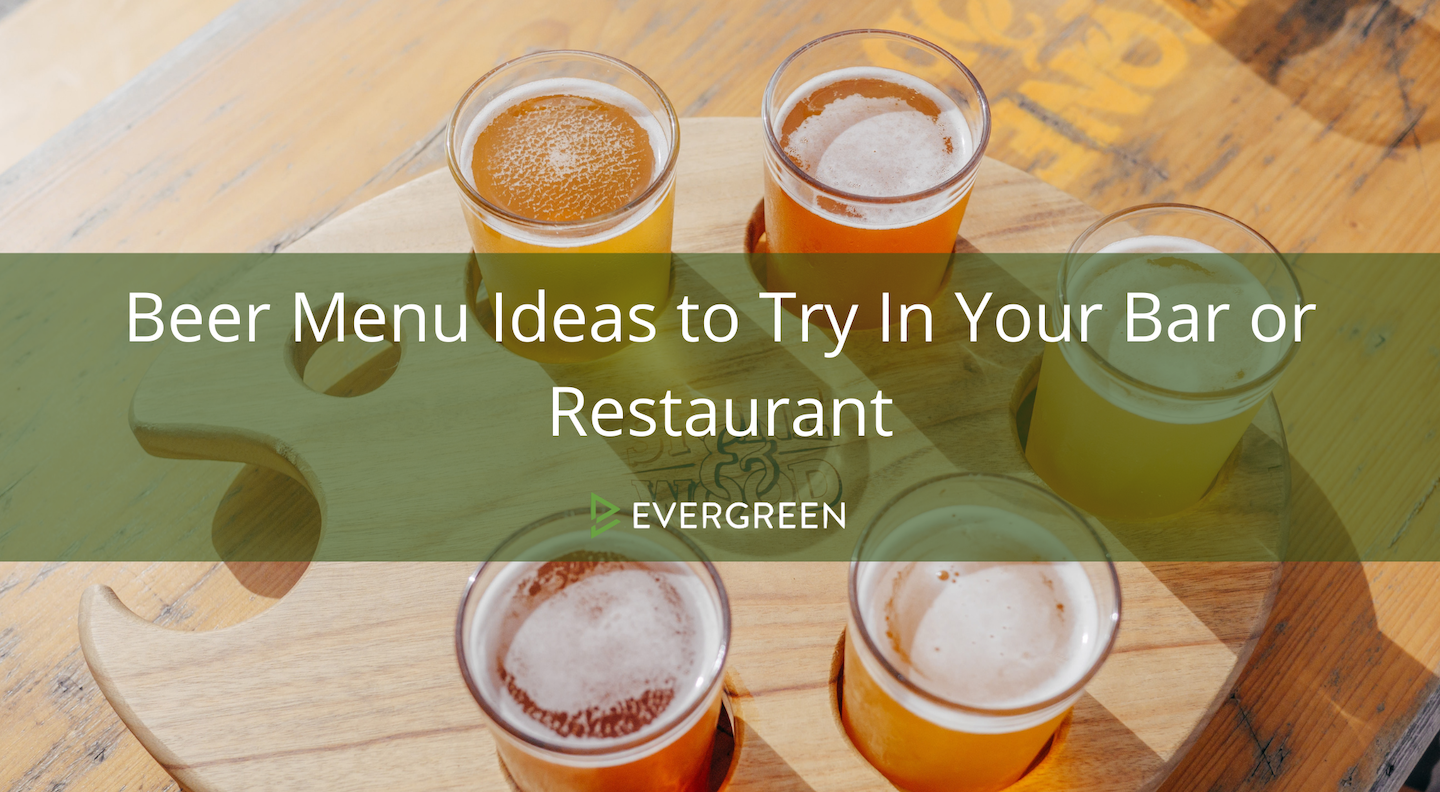A well-designed beer menu is crucial for attracting customers and boosting sales. In today’s competitive market, having a standout beer menu can make all the difference for a bar or restaurant.
Ready to see what beer options await you? Let’s dive into proven beer menu concepts that can make your hospitality business more money.
Why Beer Variety Is Important
Customers often visit establishments with the intention of trying new and unique beers, so offering a diverse selection is essential. Yard House, a popular restaurant chain, features over 100 different beers from around the world on their menu, including craft and local options. By incorporating craft and local beers, establishments not only provide customers with a wide range of flavors and styles but also support their local brewing community.
Craft beer has experienced a surge in popularity in recent years, with consumers seeking out unique and high-quality brews. By featuring craft beers on the menu, you can tap into this growing market and cater to the preferences of beer enthusiasts. Craft breweries focus on innovation and creativity, often experimenting with different ingredients and flavor combinations. By including craft beers on the menu, establishments can offer customers a chance to discover and appreciate the artistry behind these brews.
In addition to craft beers, it’s important to include popular beer styles such as IPAs, stouts, lagers, and ales. These styles have a broad appeal and cater to different taste preferences.
Lagers are characterized by a clean, crisp mouthfeel and taste, while ales offer a wider range of flavors and aromas. Stouts are rich and full-bodied, often with notes of chocolate and coffee, while IPAs are characterized by their hop-forward bitterness and citrusy flavors.
Imagine a bar that offers a limited selection of mainstream beers with no variety in styles or flavors. Customers who are looking for unique and interesting beers may be disappointed and choose to go elsewhere.
However, a bar that has a well-curated beer menu featuring a diverse range of styles, from classic to craft, is more likely to attract beer enthusiasts and curious customers. This example highlights the impact that a well-designed beer menu can have on customer attraction and satisfaction.
Types of Beer to Include in a Menu
When creating a beer menu, it’s important to include a variety of beer styles to cater to different tastes and preferences. Offering a range of flavors and intensities ensures that there is something for everyone.
Your menu should feature popular beer styles such as lagers, ales, stouts, and IPAs. These styles provide a solid foundation and appeal to a wide range of customers. Consider including non-beer items like appetizers on the beer menu.
Craft and local beers have gained immense popularity in recent years, with consumers seeking out unique and high-quality brews. Including craft and local options on the menu not only adds a unique touch but also supports the local brewing community. Customers are often drawn to establishments that offer a selection of craft beers, as they provide an opportunity to explore new flavors and support independent breweries.
A bar in a coastal town might include a selection of beers from nearby breweries that incorporate local ingredients such as sea salt or citrus flavors. This not only showcases the local brewing talent but also provides an authentic taste of the region.
Seasonal Beer Menu Ideas
Incorporating seasonal beers into the menu is a great way to keep things fresh and exciting for customers. Seasonal beers are brewed to complement specific times of the year, offering unique flavors and ingredients that evoke the spirit of the season. For example, a bar may feature refreshing summer ales with citrus notes during the warmer months, while spiced winter beers with hints of cinnamon and nutmeg are perfect for the holiday season.
Seasonal beers create a sense of anticipation and exclusivity. By offering limited-time seasonal brews, establishments can encourage customers to visit regularly to try the latest offerings. This not only increases customer engagement but also drives repeat visits. For instance, a brewpub may release a special pumpkin ale during the fall, creating excitement among customers who eagerly anticipate its arrival each year.
To provide a concrete example, let’s consider a bar that regularly updates its beer menu to align with the changing seasons. During the spring, they introduce light and refreshing beers such as wheat beers and fruit-infused ales to complement the warmer weather.
In the summer, they feature crisp and citrusy IPAs and lagers that are perfect for outdoor gatherings. When fall arrives, they showcase seasonal favorites like Oktoberfest beers and pumpkin ales.
Finally, during the winter, they offer rich and robust stouts and porters to provide warmth and comfort on cold nights. This rotation of seasonal beers ensures that customers always have something new and exciting to try.
By incorporating seasonal beers into the menu, establishments can keep customers engaged and eager to explore new flavors. It also allows them to showcase their creativity and adaptability, demonstrating that they are constantly refreshing their offerings to cater to their customers’ changing preferences.
Beer Pairing Suggestions
Beer pairing is a fantastic way to enhance the dining experience and showcase the unique flavors of different beers. Just as wine is often paired with specific dishes, beers can also be paired with various food items to create harmonious flavor combinations.
When designing a beer menu, it’s important to consider offering beer pairing suggestions for different dishes on the menu. This provides customers with guidance and enhances their overall dining experience.
Beer pairing suggestions can be as simple as indicating which beer style pairs well with a particular type of cuisine. For example, suggesting pairing hop-forward IPAs with spicy dishes to balance the heat, or recommending pairing malty and caramel-flavored beers with grilled meats for a complementary flavor profile. By including these pairing suggestions in the menu, establishments can help customers make informed choices and discover new flavor combinations.
Beer pairing suggestions can also be used to highlight the unique flavors of different beers and encourage customers to try new combinations. A bar may suggest pairing a fruity wheat beer with a tangy goat cheese salad, as the flavors of the beer and cheese complement each other.
Similarly, they may suggest pairing a chocolate stout with a rich chocolate dessert to create a decadent and harmonious experience. These pairing suggestions can inspire customers to explore new taste combinations and elevate their overall dining experience.
It’s important to note that staff training is crucial when it comes to beer pairing suggestions. By providing staff with knowledge about the flavor profiles of different beers and their compatibility with various dishes, they can offer personalized recommendations and enhance the overall customer experience. Staff members can also share their own favorite beer and food pairings, adding a personal touch and creating a friendly and knowledgeable atmosphere.
5 Tips for Creating an Appealing Beer Menu
Creating an appealing and user-friendly beer menu is essential for driving sales and enhancing customer satisfaction. Here are some additional tips to consider:
- Organize beers by flavor profile: Grouping beers based on their flavor profiles, such as hoppy, malty, or fruity, can help customers quickly find the beers they prefer. This organization can also help customers navigate the menu and discover new beers within their preferred flavor profile. For example, a bar may dedicate a section of their menu to hop-forward IPAs, showcasing a variety of options with different hop intensities and flavor profiles.
- Simplify the ordering process: Use tap numbers to streamline the ordering process, allowing customers to easily identify and order their desired beers. This simple numbering system can save time for both customers and staff, ensuring a smooth and efficient ordering experience. Your bar may have a large selection of beers on tap, and each beer is assigned a specific tap number. Customers can simply refer to the tap number when ordering, eliminating any confusion.
- Incorporate beer pairing ideas: Include beer pairing suggestions in the item descriptions to encourage customers to try different combinations and increase sales. By highlighting the complementary flavors of beer and food, establishments can guide customers towards enjoyable and memorable dining experiences. For example, a restaurant may describe a particular burger on the menu and suggest pairing it with a specific beer style to enhance the flavor experience.
- Keep the menu up-to-date: Regularly update the beer menu to avoid frustrating customers with out-of-stock options and to showcase new arrivals. This ensures that customers have accurate and current information about the available beers, preventing disappointment and enhancing their overall experience. Your bar may have a rotating selection of guest taps and regularly update the menu to reflect the latest offerings.
- Highlight special sections: Create sections like “Staff Favorites” or “Top Sellers” to highlight popular or unique beers, catching the attention of customers and influencing their choices. This can create a sense of excitement and curiosity among customers, encouraging them to try the recommended beers and explore new options. For instance, a bar may have a section on their menu dedicated to showcasing the favorite beers of their knowledgeable staff members.
If you leverage any of these tips, you can further enhance the appeal and functionality of your beer menu. A well-designed and well-organized beer menu can capture the attention of customers, guide their choices, and contribute to a positive and memorable dining experience.
3 Beer Menu Design Ideas
The design of a beer menu plays a crucial role in catching customers’ attention and piquing their interest.A visually appealing menu with a thoughtful layout and attractive design elements can create a positive first impression and make customers excited to explore the beer menu templates. When designing a beer menu, consider the following three design ideas:
- Opt for visually appealing menu designs: Choose a design that stands out and aligns with the overall branding and atmosphere of the establishment. For example, a modern and minimalist design may be suitable for a contemporary bar, while a rustic design with vintage elements may complement a traditional pub setting. The design should reflect the personality and ambiance of the establishment, creating a cohesive and memorable experience.
- Explore different templates: There are various templates available for creating beer menus, ranging from simplistic to elaborate designs. Websites like MustHaveMenus offer a variety of customizable beer menu templates that establishments can choose from. For example, they may offer options such as rustic or contemporary templates, allowing establishments to select a design that best suits their aesthetic.
- Customize the design to fit the branding: It’s essential to customize the menu design to align with the establishment’s branding. This includes incorporating the logo, using consistent fonts and color schemes, and ensuring that the overall design is reflective of the establishment’s identity. By creating a cohesive visual identity, establishments can strengthen their brand and leave a lasting impression on customers.
To provide a practical example, let’s imagine a brewpub with a modern and industrial aesthetic. The beer menu for this establishment could feature a sleek and minimalist design with clean lines and bold typography. The menu might be designed with a dark color scheme to evoke a sense of sophistication.
Additionally, the menu could incorporate subtle elements such as hop icons or beer-related illustrations to enhance the overall beer-focused theme. By customizing the design to fit the establishment’s branding, the beer menu becomes an extension of the overall experience and reinforces the establishment’s identity.
Incorporating Non-Beer Items
Including non-beer items on a beer menu can be a strategic decision that diversifies the offerings and attracts a wider range of customers. While beer is often the main focus, incorporating food items or other beverages can provide more options for customers with different preferences. Striking a balance between beer and non-beer offerings is essential to cater to a diverse customer base.
To illustrate the benefits of incorporating non-beer items, let’s consider a bar that offers a selection of appetizers alongside their beer menu. By doing so, they provide customers with the opportunity to enjoy a snack or a light meal while they socialize and enjoy their beer.
This can be particularly appealing to customers who prefer to have some food alongside their drinks. Additionally, offering food options can increase overall sales, as customers may be inclined to stay longer and order more when they have access to both beer and food.
When incorporating non-beer items into the menu, it’s important to consider the overall theme and atmosphere of the establishment. The food items should complement the beer offerings and align with the target demographic.
A bar with a focus on craft beers may choose to offer artisanal cheese and charcuterie boards to pair with their beer selection. On the other hand, a sports bar may offer a variety of hearty appetizers and finger foods that are perfect for sharing while watching a game. By aligning the non-beer items with the establishment’s concept, establishments can create a cohesive and enjoyable dining experience for customers.
3 Ways to Stand Out from the Competition
In a competitive market, it’s essential for establishments to find ways to stand out from the competition. A well-designed and thoughtfully curated beer menu can be a valuable tool in differentiating from other establishments. Here are some strategies to consider:
- Use unique formats or sizes: Experimenting with different formats or sizes for the beer menu can make it stand out. For example, a bar might choose to create a menu in the shape of a beer bottle or use a larger format to showcase vibrant beer photography. These creative approaches catch the attention of customers and make the menu memorable.
- Promote social media or happy hour specials: Utilize the menu header to promote social media handles or highlight happy hour specials. By including social media icons and handles, establishments encourage customers to engage with them online and stay updated on the latest news and offerings. Additionally, highlighting happy hour specials on the menu can attract customers during specific times, increasing foot traffic and sales.
- Consider using QR Code menus: QR Code menus have gained popularity as a convenient and sustainable alternative to traditional printed menus. By using QR Code menus, establishments can eliminate the need for printing and easily update the menu in real-time. This keeps the menu up-to-date and reduces waste. Customers can simply scan the QR Code with their smartphones to access the digital menu.
As a simple example, let’s imagine a brewpub that wants to stand out from the competition. They decide to create a beer menu in the shape of a beer bottle, complete with a label design that showcases their logo and branding.
This unique format catches the attention of customers and creates a memorable impression. Additionally, they use the menu header to promote their social media handles, encouraging customers to follow them for updates on new beer releases and special events.
They also incorporate a QR Code on the menu, allowing customers to access a digital menu with additional beer information and food pairing suggestions. These strategies help the brewpub differentiate itself from other establishments and create a unique and engaging experience for customers.
Importance of Menu and Loyalty Program Software
In addition to design resources, establishments can benefit from menu and loyalty program software. These software solutions streamline menu creation, updates, and loyalty program management, making it easier for establishments to manage their operations and enhance customer experiences.
Evergreen is an example of such software that offers end-to-end capabilities for bar and restaurant needs. Our menu and loyalty program software provides establishments with easy customization options, allowing them to create and update their menus with minimal effort.
The software offers a user-friendly interface that enables establishments to make changes to their menu in real-time, ensuring that customers always have access to the most up-to-date information. Additionally, the software allows establishments to create and manage loyalty programs, providing incentives for customers to return and engage with the establishment.
Elevate Your Beer Menu and Boost Sales
A well-designed beer menu with creative ideas, diverse beer options, and seasonal offerings can significantly impact customer satisfaction and sales. By offering a variety of beer styles, including craft and local options, establishments can cater to different customer preferences and support their local brewing community. Incorporating seasonal beers into the menu keeps things exciting and encourages customers to visit regularly to try the latest offerings.
With a well-designed beer menu and the right tools, you can create multiple compelling offerings that motivate customers for multiple return visits. Ready to bring your business to the next level? Book a demo today to see what we’re all about!













